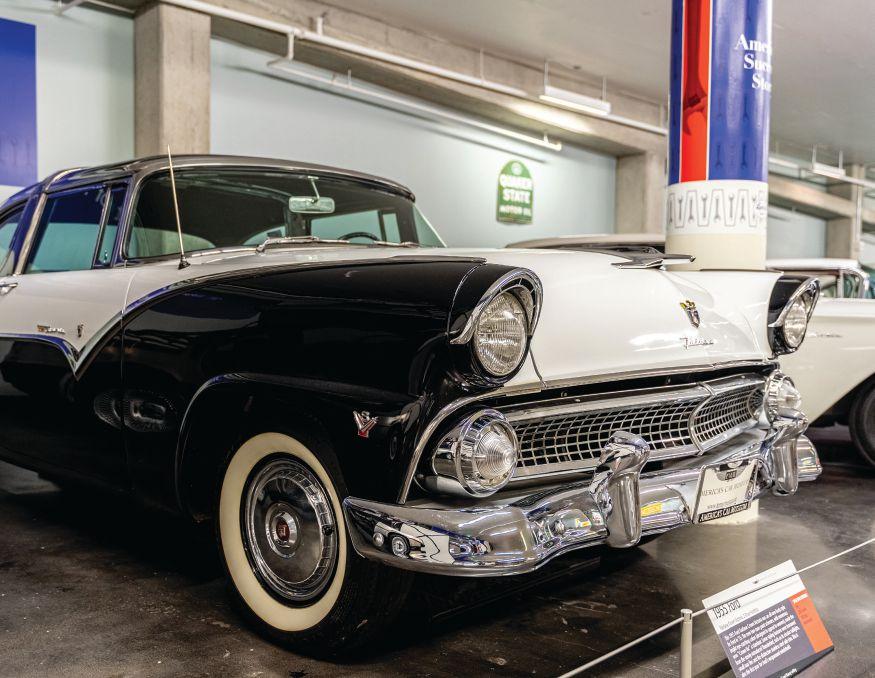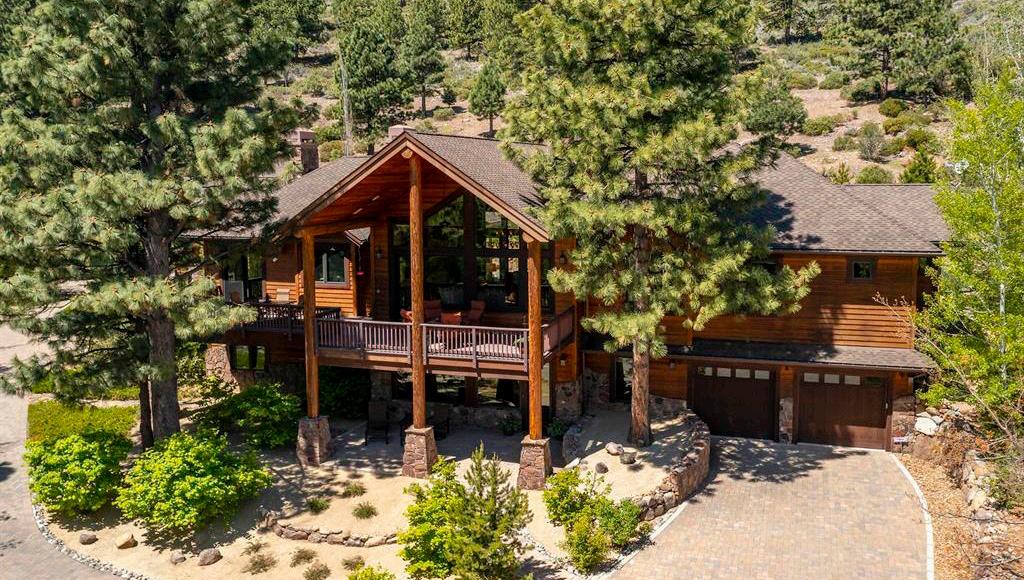
6 minute read
SPIN WITH THE FIN
By LINSEY STONCHUS
Few things epitomize American culture more than classic cars. Autos made during the 1950s were so enmeshed with society at the time that their influence on one another was indistinguishable.

During the decade, cars moved beyond sheer practicality and evolved into a pastime, evident in the rise of drive-in theaters, rock and roll, and expanding highway that forever changed city layouts and the ways in which regions of the country connected.
“The Fifties is arguably one of the most significant decades in all of automotive history,” says Jake Welk, marketing manager at LeMay — America’s Car Museum in Tacoma, Washington.

This shift in purpose was apparent in auto design.
“Cars of the ‘50s became sexier, with distinctive colors like greens, blues, yellows and pinks, along with flashy trim with heavy use of chrome on long, wide bodies,” Mr. Welk says. “Big headlights, chrome grilles, large tailfins and an overall flowing design were common.
“This shaped the way we view cars forever, looking at them more as a status symbol and with a sense of fashion and creative and expressive design in a way that had never been seen before,” he says.

Taking Flight
Much of the cultural shift in the ‘50s is attributed to changing sentiments post-World War II. Not only was the car a simpler way to transport expanding families, but pop culture and entertainment were booming. Enjoying oneself was a top priority.
“Everybody was looking forward to something new,” says Chris Horning, car designer at the Gilmore Car Museum in Hickory Corners, Michigan. “It was a relief, you know. The world had been in a bad place for a long time and, all of a sudden, it wasn't any more.”

Technological advancements, including those of the previous decade’s war, greatly affected car design.
“It’s a distinctive era in design,” Mr. Horning says. “In the ‘50s, right after the war, rockets were a big deal, so you see cars with great big, huge taillights that looked like rocket exhaust.”
In the mid-1950s, the Space Race took hold and commercial air travel was on the rise, further influencing design with features that mimicked the wings of an airplane and other fuselage-inspired attributes. These designs were slimmer and sleeker than the boxy models of the early decade.
“Anything from 1955 on seems to be more popular than the early‘50s cars, just because the design style was inspired by fuselage and was more streamlined, rather than the chunky look,” Mr. Horning says.
The 1957 Chevrolet Bel Air, for instance, one of the most iconic cars of the time, featured sleek tailfins on the back of the car. The 1959 Cadillac Coupe DeVille, meanwhile, sported a wraparound windshield resembling that of an airplane.

“The ‘50s era certainly was space- and jet-age,” Mr. Horning says. “We see these in the big tailfins and science fiction-looking interiors.”
The boom in travel, both on the road and in the skies, in turn, influenced the infrastructure of the United States.
“Automobile design had an effect on the architecture of the United States and the way the towns were laid out,” Mr. Horning says.
Mr. Welk adds that “the highway system and infrastructure began to expand, creating longer roads that interconnected cities and states and allowed for higher-speed travel.”
Just as the rise of the automobile affected city layouts, better infrastructure led to even more drivers on the road, and the loop continued. The expansion of driving also meant safety was an increasing imperative.
“They began to adapt by adding new, innovative features and designs that created a whole new experience for the driver, including the introduction of power steering and automatic transmissions,” Mr. Welk says. “Many of these design and safety features are still seen in cars being built today.”
Tough Birds
Aside from the design and culture surrounding classic cars, their durability ensured their longevity.
“Cars in the ‘50s were built very well and sturdy, and many of the vehicles that were built in the ‘50s that have been properly taken care of and restored over the years are still very durable and drivable, just as they were back when they were created,” Mr. Welk says.
Most collectibles are the makes and models most popular during the decade.
“The Big Three, as they became known, were General Motors, Chrysler and Ford,” Mr. Horning says. “Whatever they put out seemed to stamp out the other companies that were lacking in their engineering or development. They couldn't offer all the options, and they fell behind.”
No feud, however, was as grand as General Motors’ Chevrolet race against Ford, which lingers today.
“The age-long argument ‘Ford-versusChevy’ really took flight in the ‘50s,” Mr. Welk says. “Both of these automobile manufacturers were fighting toe-to-toe in competition to outdo each other and produce the best, most-wanted vehicles on the road.”
Chevy gained even more popularity with singer Dinah Shore’s 1952 commercial turn urging Americans to “See the U.S.A. in your Chevrolet.”
The Ford Thunderbird was created to compete with the Chevrolet Corvette and, in its debut in 1955, greatly outsold the latter. Primarily, the battle was in the engine's performance, with the rivals hoping to outpace one another in horsepower and speed.

Both models, however, remained icons of the 1950s, with versions released as late as 2005 for the Thunderbird and 2019 for the Corvette.
Other General Motors standouts included Buicks and Cadillacs, known for their luxury and family-oriented vehicles, such as the high-end Cadillac Series 62 or spacious Buick Special models.
Packing It In
Less loved during their time were Studebakers and Packards, which have more recently found popularity as collector cars.

The 1951 Studebaker Commander was most famous for its “bulletnose” rounded front-exterior design, with the company advertising at the time, ‘The Next Look in cars is a ‘Jet-Propelled Look!’
Unfortunately for Studebaker, the bullet-nose was short-lived and only a feature in its 1950–1952 models, as the company was sued by rival Tucker for patent infringement because it mimicked the design of some of Tucker’s models.
That said, this lawsuit was not Studebaker’s downfall. Financial issues haunted the company for decades before releasing its last model in 1966. Many experts now assert that, in retrospect,
Studebaker was ahead of its time. It saw smaller cars as the future, which came to fruition in later decades, but released them too soon, at a time when bulkier cars were in vogue.
Packard released its last model in 1956. Although Packards were exceptional cars, they were quite expensive and could not remain competitive in the market.
Despite being beloved at car shows, old Packards and Studebakers are much more challenging to restore.
“They're far more difficult to restore because there aren't as many of them and people don't tend to make the parts for them anymore,” Mr. Horning says. “There's a huge market for ‘55 Chevy parts because there were so many made. Not so much a ‘55 Packard.”
Joining The Race
European cars made their own mark on the industry. Leisurely vehicles were not the initial priority, but as the decade went on, the continent increasingly manufactured luxury and sports cars.
Post-World War II, “Europe was rebuilding, while the U.S. was building upon,” Mr. Horning says. “They were looking for cars that were much smaller and easier to drive around, and inexpensive trucks for hauling and fixing things and construction, so they developed truck companies that eventually turned into, or merged with, automobile companies.”
Horton, Opel and Audi are just some examples.
“It wasn't until much later in the ‘50s, after they got done rebuilding, that amazing cars came out, like the Mercedes 300SL and Ferraris,” Mr. Horning says. “The racecars that came from Europe were just incredible cars.”
Meanwhile, Rolls-Royce Motor Cars and Bentley Motors were the epitome of luxury.
“That’s how the whole United States sports car clubs started, because these soldiers brought all these really cool cars back over,” Mr. Horning says.
Up The Volume
Without question, the effects of the 1950s automotive industry are still felt today. The decade’s influence can be found all over American culture and in hints of modern vehicles.


“The ‘50s really shaped the way our society and culture is in America and laid the foundation for the way Americans have lived over the past 70 years since,” Mr. Welk says.
“Modern-day cars were, no doubt, shaped by the design features and innovations that were introduced in cars of the ‘50s,” he says. “However, cars, over time, have become more practical, focusing on safety and making the experience for the driver easier.”
Automobiles are also produced at far greater a scale, and with hybrid and electric-motor options in addition to gaspowered combustion engines.
“Cars now are mass-produced like never before, and automotive manufacturers are now more focused on providing a high volume of vehicles for consumers rather than focusing on making them exotic and unique,” Mr. Welk says.
YET THE INGENUITY of artistry and machinery persists in the decades-old vehicles still driving today, their quality undeniable. Alongside the physical cars are the memories.
“[Collectors] keep that interest in this area because they have these wonderful stories that they can relate to, that were told to them by their aunts and uncles and grandparents growing up and shared for years,” Mr. Horning says. “It’s fun to go to a car show and share the stories.”
Mr. Welk agrees.
“The automobile has always been one of America’s favorite pastimes,” he says. “It creates passion in all of us and connects us together in a way many other things cannot.”











